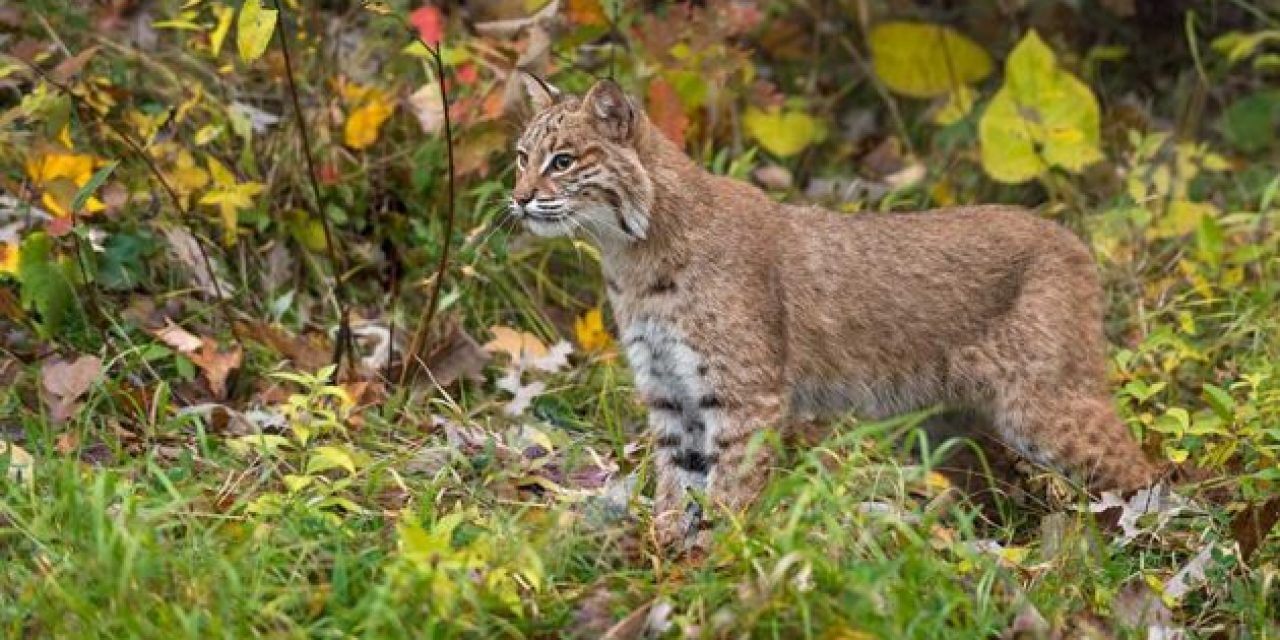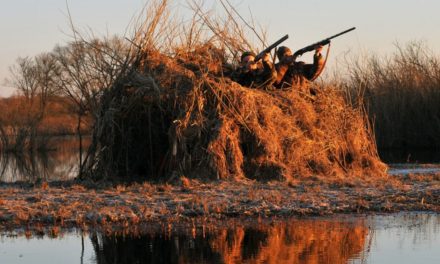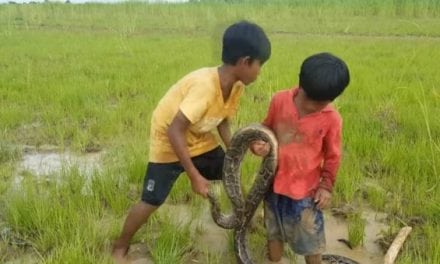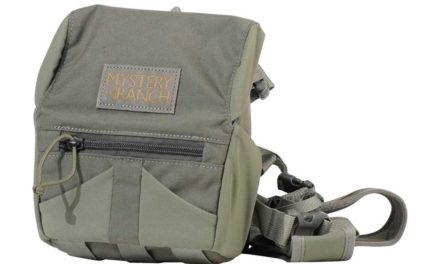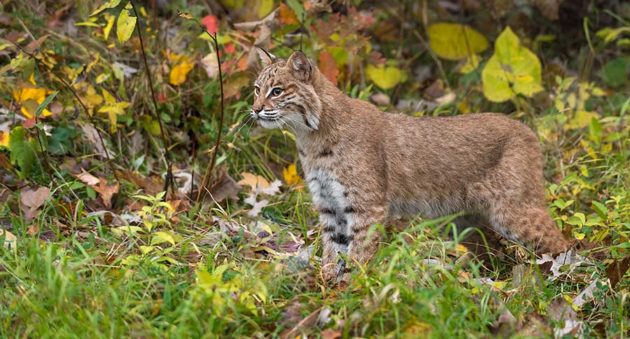
The elusive bobcat roams the North American woods and is one of the most interesting animals out there.
While cougars may be the first thing you picture when you imagine North America’s wild cats, there’s another species that’s just as fascinating as its larger cousins: the bobcat.
Bobcats are solitary creatures that live throughout most of North America and adapt well to a wide range of habitats such as forests, swamps, deserts, and even semi-populated areas.
Roughly twice the size of the average house cat, bobs (as they are known in some areas) are distinguished by their soft, spotted fur that is prized by trappers, and their short, stubby tail that defines their name.
It may be a bit confusing, but the scientific name of the bobcat is lynx rufus. The animals are widespread with significant populations, which National Geographic says is “as many as one million cats in the United States alone.”
The home range for bobcats includes a wide area of the North American continent and extends into southern Canada as well, but bobcat sightings are still a rare occurrence for some. These carnivores aren’t mountain lions, but can still be quite ferocious when they come into contact with human populations.
Bobcat Diet
The bobcat is a fierce and cunning predator that is renowned for its stealthy hunting ability and its incredible perseverance while on the prowl. These animals will hunt and eat squirrels, mice, rabbits, birds, and even fish like salmon, but they can and will attack animals that are much bigger than they are and be successful at doing it.
Bobcats are sometimes confused with its northern cousin the Canada lynx due to a similar appearance, but lynx are somewhat larger animals and more adapted for life in northern climates, particularly for living in the snow.
In fact, the Smithsonian’s National Zoo says, “As adaptations to the lower temperatures of -70 F (-57 C), they have shorter tails than bobcats and their footpads are well protected with a dense covering of fur, while those of the bobcat are bare. The longer legs of the lynx are also an adaptation to traveling through deep snow, where the bobcat is at a disadvantage.”
But make no mistake: they are both top level predators, and this is a marked reason why we love them so much.
Bobcats usually hunt at night, but this cat made an exception to take advantage of salmon spawning season.
Posted by National Geographic on Tuesday, January 31, 2017
Specific Bobcat Characteristics
Bobcats have a base color of gray or slightly yellow with spots, sometimes seen as a brown to off-red with ears that are tipped in black and slightly pointed, with short, dark tufts appearing the top.
These carnivorous wild cats can be 30-40 inches long and weigh as much as 30 pounds, sometimes living up to 10 years in the wild. In 2012 a bobcat was killed by a car in New Hampshire that weighed a whopping 60 pounds!
The bobcat’s eyes are yellow with round, black pupils, giving them maximum light perception in the dark, which is when they mainly hunt. Bobcat’s have insanely good hearing and sense of smell, but the thing that really sets them apart is their dexterity and drive when it comes to hunting.
A friend of mine filmed this the other day in his backyard. Who needs Netflix when you have this to watch!
Posted by Justin Stovall on Saturday, April 25, 2020
Bobcat Communication
Bobcats find one another through scent marking, visual signs, and at times vocalization. Bobs drop scent by urine, anal gland secretions, and by scat or feces. Body posture sometimes comes into play along with facial expressions as an effective close range signal to warn off intruders.
During their breeding season, their vocalizations come in the form of screaming that has to be heard to be believed.
Check this out (sound on)Sent to us by Scott Higgins #hunt #fish #read
Posted by Woods-N-Water News on Friday, April 5, 2019
Breeding
Bobcats come into maturity and begin to breed around their second year with dominant adult males chasing the females in February and March. Once successful mating has happened, the gestation period is usually 60-70 days with the kittens being born in April and May.
After being weaned at around two months, the bobcat kittens will begin to follow their mother and learn to hunt from her, generally by the autumn of the first year of their life cycle.
After that, they disperse depending upon their maturity, sometimes following the mother for one winter.
Bobcat mom with her growing kittens
It's like mom is saying… come on, hurry up! What's taking so long? We're going to be late!Check out my site: https://www.urbanedgewildlife.org for more videos and articles featuring wildlife on a urban edge trail. #FelidaeFund
Posted by The Cat Coach LLC on Monday, March 4, 2019
Range
Adult bobcats are widely distributed across the U.S. and across parts of Canada, but not as much in the central farming areas and the urban east coast. The largest-bodied bobcats are from the eastern part of Canada and the northern New England states.
Bobs also dwell in the desert regions of the southwest, living in the dense chaparral and scrubland across transitional zones between woodlands and grasslands.
Hunting for Bobcats
EXTEND YOUR SEASON WITH PREDATOR HUNTING – All you need is a hunting license, gun & call, and some basic knowledge. Learn how here…*Get Hunting Licenses –> https://app.fw.ky.gov/solar/*Watch more videos –> http://www.wiredoutdoors.com/ Wired Outdoors #ToothandClawTV #huntKY #Bobcats #Coyotes #Foxes #myKYoutdoors
Posted by Kentucky Department of Fish and Wildlife Resources on Tuesday, January 16, 2018
By researching onXMaps and more than a handful of state wildlife agencies and regulatory sites, I found that 39 states currently offer bobcat hunting to outdoorsmen, with most offering trapping as well. At this time Indiana and Ohio sportsmen and women are actively working to get their respective states an open season. Alaska and Hawaii have no viable populations of bobcat that we know of.
Centerfire rifles or slug shotguns are the most common methods of take, with bowhunting following somewhere behind. If you are wondering how slug shotguns and archery come in to play, they are certainly viable methods to take bobcats, but just remember that old adage that we all live by: it doesn’t matter what we’re hunting, if we see a predator, it turns into a predator hunt.
It is very important to know the legal hunting regulations beforehand. For instance, I hunt in New York State and the season is officially closed for both bobcat and coyote once the spring turkey season opens in the month of May. This means the taking of either of these fur bearers would be illegal at that time.
For the serious predator hunter, it all starts with caliber. While any good quality rifle can work well, there are differences that should be noted and included in your thinking.
If you are just out to harvest bobcats then, anything up to a .270 will work, but for those of us that are considering the coat, many take to the .223 like a fish to water. Using a good deer rifle to take down smaller animals may not be necessary, but you will still need power and accuracy to get the job done.
MSRs such as the AR-15 series can make much faster follow up shots than a standard bolt action rifle. This is a good choice due to its range and especially since the semi-automatic setup will keep you firing as long as you can keep your crosshairs on the target.
MSRs usually allow for the use of bipods and suppressors to outwit wily bobcats and other predators.
The top states for bobcat hunting are Kansas, Missouri, Nevada, Oklahoma, Oregon, New Mexico, and Georgia.
Trapping for Bobcats
Who else watched this 5 times? 🤯💎🎥|| @jungleexploree#bobcat #crazycatlady #cats #videooftheday
Posted by Ocean Magazine on Tuesday, May 12, 2020
Many outdoorsmen still set traplines for predators, and bobcat pelts are a big draw. Where legal, the lucrative market for pelts can make a trapper’s wallet mighty fat.
Finding sign of your quarry is important, but knowing your area is most crucial. Out west they look for rock outcroppings where cats like to observe prey from above; in the east, they look for sign in cover around deer trails near wooded areas. They’ll place their sets in dugout holes, covering the trap with fresh earth and then baiting it, many times with rabbit and even fish (some trappers make good use of roadkill bunnies in their set).
According to Trapping Today, “The top Western cats with wide white, spotted bellies are still in demand for the high end fashion market and should continue to average $300-400, but this market is highly specialized and doesn’t have much use for the rest of the cats. Bobcats from most other parts of the country should average $30-60, with some falling in between the two extremes.”
The bobcat is a particularly interesting North American mammal and deserves all of the respect that we can give it.
Looking for a little more? Follow my webpage, or on Facebook and Twitter.
NEXT: LEUPOLD DEBUTS NEW LINE OF PERFORMANCE EYEWEAR
WATCH
The post Bobcat Facts: How Much Do You Know About North America's Feline Predator? appeared first on Wide Open Spaces.

